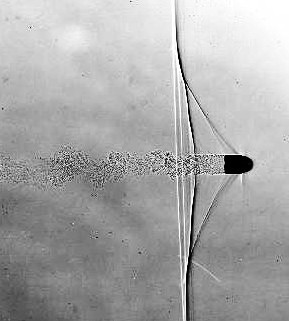
- prehistoric shadowgraphy
- sunlight shadowgram of a martini glass
- "focused" shadowgram of a common firecracker explosion
- "Edgerton" shadowgram of the firing of an AK-47 assault rifle
Shadowgraph is an optical method that reveals non-uniformities in transparent media like air, water, or glass. It is related to, but simpler than, the schlieren and schlieren photography methods that perform a similar function. Shadowgraph is a type of flow visualisation.
Contents
- Sunlight shadowgraph
- Applications
- Shadowgram (Shadowgraph)
- Cartoons
- Postcards
- Gallery
- See also
- References
In principle, a difference in temperature, a different gas, or a shock wave in the transparent air cannot be seen by the human eye or cameras. However, all these disturbances refract light rays, so they can cast shadows. The plume of hot air rising from a fire, for example, can be seen by way of its shadow cast upon a nearby surface by the uniform sunlight.


